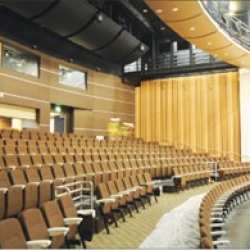With today being Mozart’s birthday, it is apropos that we at Festival Mozaic recently came across the following essay. Penned in 2006 by Music Director Scott Yoo, it lauds Mozart’s creativity and genius on the occasion of his 250th birthday. (When Maetro Yoo wrote the piece, Festival Mozaic was still called the San Luis Obispo Mozart Festival, but we honor and revere Mozart’s musical legacy as much today as we ever have.) Thanks to local newspaper The Tribune for printing the original words.
Enjoy!
This weekend marks the beginning of worldwide celebrations honoring the 250th birthday of one of the greatest musical artists the world has known, Wolfgang Amadeus Mozart. The celebrations across the globe have given me occasion to muse on what Mozart meant to his own time, to ours and to the future.
In my travels as a guest conductor, I am fortunate to work with orchestras in many countries. My recent musical travels have taken me to a 2-week stint of guest conducting Mozart in Hong Kong and I am now guest conducting an orchestra on the East Coast in a Mozart program as well. A musician in Hong Kong remarked to me that that he could play Mozart all year round and be completely satisfied, which led me to wonder: what is it about Mozart’s music that makes it so easily ‘portable’, not only through time zones, but thorough cultures as disparate as America and Asia? And why does his music still feel so fresh, after almost a quarter of a millennium?
Despite the entertaining but historically-suspect film Amadeus, which depicts Mozart as a puerile idiot-savant, Mozart the man remains an enigma to us. Unlike some of the latter composers who followed him, it is difficult to tell from Mozart’s music what was happening in his life. He didn’t necessarily write ‘sad’ music when he suffered loss or set-back or ‘triumphal’ music when he achieved something of great public acclaim. His output remained constant and consummate in quality, in scope and in sheer creativity.
Legends of his genius come to us because of the process by which he created music, which was so effortless, that it was said to come directly from God’s mind to Mozart’s hand. Musicians still stand in awe of this ability, knowing what it entails. The ease with which he created is not what makes him so popular with audiences, whose appreciation of music is not based on how difficult something is, but what it elicits emotionally and imaginatively.
Mozart’s supernatural ability to span a range of emotions from happy to sad, aggressive to plaintive, jovial to funereal, in a matter of seconds, without ever sounding abrupt is partly what makes him unique among composers. As we multi-process and multi-task our way through modern life, there is something in this ability to “turn on a dime” that so mirrors the way we perceive the world, think and feel inside ourselves, that makes this music feel so natural to us, so human, that it resonates across cultures and centuries. This is what makes Mozart so lasting and eternal, from Virginia to Hong Kong and all places and eras in between.
The Central Coast is indeed fortunate to have a festival that celebrates this expressive and creative legacy each summer and throughout the year. Although festivals, orchestras and opera houses across the world will honor Mozart with performances of his works both great and small throughout the year, here in San Luis Obispo, we have chosen to take a different approach. This year, the San Luis Obispo Festival celebrates the 250th anniversary of the birth of its namesake by showcasing the greatest works by the master himself and the musical titans who followed him in the 19th and 20th centuries. Many composers have contributed to the rich legacy of the classical tradition we enjoy today, but three in particular stand out and will be showcased as part of this summer’s festivities. Mozart’s poignant and effervescent classicism in the 18th century gave way to the thunderous output of Beethoven in the 19th century and the musical and personal struggles of Shostakovich working under Stalin’s repressive regime in the 20th century. Each of these three giants of music not only represented but defined their times. Mozart’s era encompassed the Enlightenment and the birth of the greatest democracy in the history of the world, our nation. Beethoven’s music championed the spirit and dignity of the individual, which arguably led to Shostakovich’s work as a lightning rod of the conflict between the stifling ideology of Stalinism and the irrepressible creative impulse of humanity.
In celebrating Mozart this year as the starting point for the musical titans in the centuries that followed, the 2006 Mozart Festival celebrates the triumph of the creative spirit through music, in our history, in our community and in ourselves.









